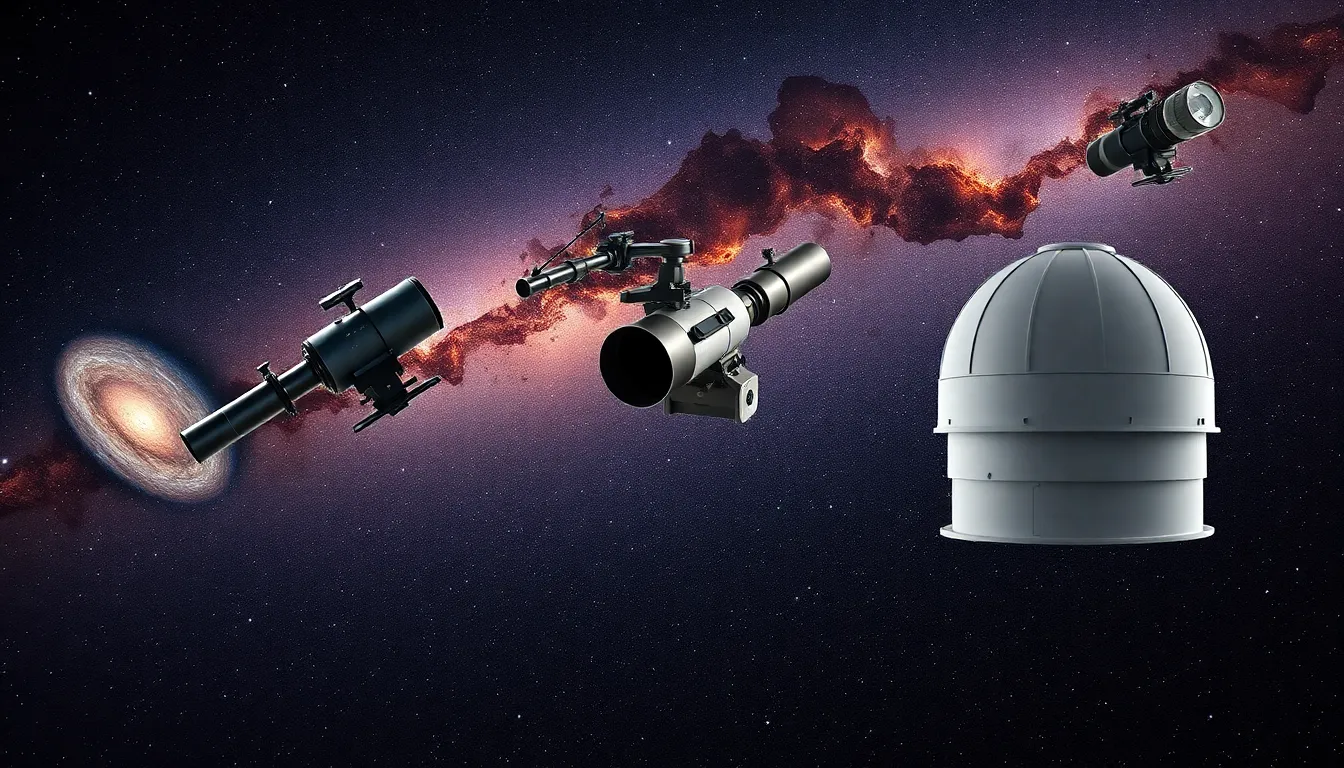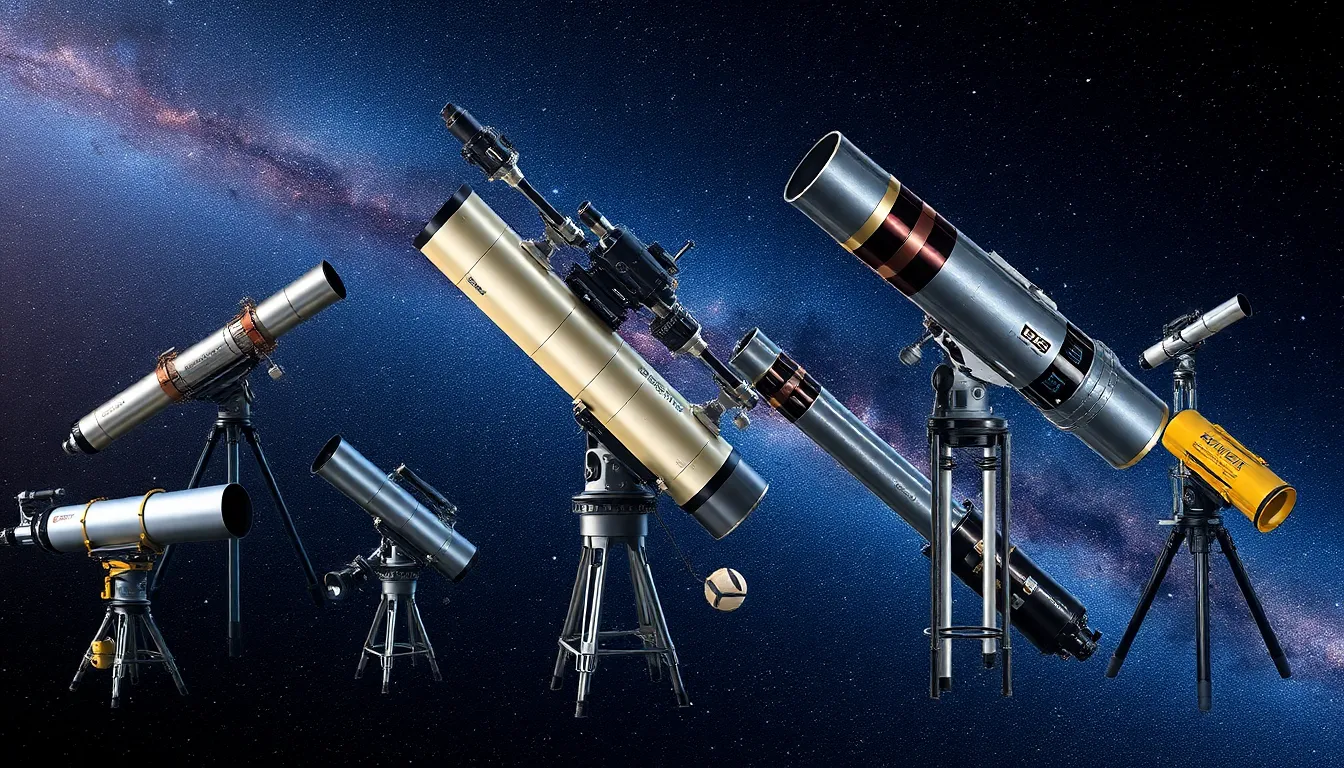The universe is a vast playground filled with cosmic wonders, and space telescopes are the curious kids on the block, peering into the depths of the cosmos. Ever wondered just how many of these high-tech marvels are out there? It’s a question that tickles the imagination and sparks a sense of adventure.
Table of Contents
ToggleOverview of Space Telescopes
Space telescopes play a crucial role in modern astronomy, offering unique viewpoints of celestial bodies. Multiple space telescopes exist, each serving different scientific purposes and employing various technologies. The Hubble Space Telescope remains one of the most notable examples, operating since 1990 and providing invaluable data on distant galaxies and nebulae.
NASA and ESA collaborate on several key missions. The James Webb Space Telescope, launched in December 2021, focuses on infrared observations, dramatically enhancing the understanding of star formation. Meanwhile, the Chandra X-ray Observatory specializes in capturing high-energy phenomena, such as black holes and supernova remnants.
Other notable space observatories include the Kepler Space Telescope, dedicated to discovering exoplanets, and the European Space Agency’s Gaia mission, which maps our galaxy with unparalleled precision. Each telescope contributes significantly to our comprehension of the universe’s evolution and structure.
As of early 2023, over 20 operational space telescopes exist, with new missions frequently planned. These instruments combine advanced optics and sensors to study various wavelengths across the electromagnetic spectrum. Ongoing research continues to unveil additional opportunities for exploration and discovery.
Space telescopes fundamentally enrich humanity’s understanding of the cosmos, they challenge previous notions and expand horizons. Their contributions not only reveal breathtaking images but also deepen insights into the fundamental laws governing the universe.
Major Space Telescopes

Space telescopes serve as vital instruments in our exploration of the universe, each uniquely designed to unveil specific cosmic secrets.
Hubble Space Telescope
The Hubble Space Telescope launched in April 1990. It orbits Earth at an altitude of about 340 miles. This telescope primarily observes in ultraviolet and visible light, providing clarity and detail in its images. Hubble’s key discoveries include the measurement of the universe’s expansion rate and the identification of exoplanets. Astronomers rely on its expansive database to study galaxies, nebulae, and star clusters. It has produced over 1.5 million observations, yielding insights that continue to enhance our understanding of the cosmos.
James Webb Space Telescope
Launched in December 2021, the James Webb Space Telescope represents a significant advancement in observational astronomy. It orbits around 1 million miles from Earth and focuses on infrared wavelengths. This capability allows Webb to penetrate cosmic dust, revealing previously hidden celestial bodies. Notable research areas include the formation of stars and the analysis of exoplanet atmospheres. Webb’s large mirror and advanced instruments ensure highly detailed observations, positioning it as a key tool for unraveling the mysteries of the universe’s origins and evolution.
Chandra X-Ray Observatory
The Chandra X-Ray Observatory, launched in July 1999, specializes in high-energy X-ray astronomy. Positioned in a highly elliptical orbit, it observes astronomical phenomena like black holes and supernova remnants. Chandra’s sensitive instruments enable the detection of X-ray emissions from the hottest regions of the universe. Research outcomes include mapping the distribution of dark matter and studying cosmic explosions. Its findings have broadened the understanding of the nature and behavior of extreme cosmic environments, making it indispensable for contemporary astrophysical studies.
Other Notable Space Telescopes
Many other significant space telescopes complement the efforts of Hubble and James Webb in expanding astronomical knowledge. These instruments contribute unique observations and insights into the universe.
Spitzer Space Telescope
Spitzer Space Telescope, launched in August 2003, specializes in infrared observations, unveiling details hidden from optical telescopes. This observatory contributed to a deeper understanding of star formation, galaxy structure, and exoplanet detection. Spitzer’s ability to observe cooler objects, like gas clouds and distant galaxies, provided invaluable data, allowing astronomers to explore the early universe’s conditions. It revealed information about the composition of planetary atmospheres and detected organic molecules, fostering further research on the potential for life beyond Earth. Spitzer operated until January 2020, completing its mission with numerous groundbreaking discoveries.
Kepler Space Telescope
Kepler Space Telescope, deployed in March 2009, focused primarily on finding exoplanets by monitoring the brightness of stars. This mission facilitated the detection of over 2,600 confirmed planets, significantly advancing the understanding of planetary systems. Kepler utilized the transit method, measuring dips in brightness when planets passed in front of their host stars. Its observations reshaped the ideas about the prevalence of planets in the Milky Way. The data obtained from Kepler continues to influence ongoing research, as many exoplanets identified are located in the habitable zone, igniting interest in the search for extraterrestrial life. Kepler’s mission concluded in November 2018, leaving a lasting legacy in the field of astronomy.
The Future of Space Telescopes
Advancements in space telescope technology promise a significant evolution in astronomical research. Missions such as the James Webb Space Telescope will continue to unveil mysteries of the universe, focusing on aspects like early galaxy formation and the atmospheres of exoplanets.
Planned space telescopes aim to elevate our understanding even further. The Roman Space Telescope, scheduled for launch in the mid-2020s, seeks to map dark energy and exoplanets with unprecedented precision. This telescope’s capabilities will impact studies related to cosmic expansion and gravitational lensing.
Innovations also include the Lunar Crater Radio Telescope, which will explore the radio universe from the Moon’s far side. Such an observatory may yield crucial insights into cosmic phenomena that current telescopes cannot detect.
Future missions also encompass space telescopes focusing on other wavelengths. The Origins Space Telescope, intended for the late 2020s, aims to observe the far-infrared spectrum. Its goal focuses on the formation of stars and galaxies, linking the cosmic timeline from the Big Bang to the present.
Each new telescope not only complements previous discoveries but also expands the frontiers of knowledge. Operational telescopes interact with upcoming projects, fostering collaboration that enhances data collection and interpretation.
Space telescopes will likely define the landscape of modern astronomy. These instruments will challenge existing theories and uncover phenomena yet to be observed. As technology progresses, the universe’s secrets will become increasingly accessible to humanity, enriching our understanding of the cosmos.
Challenges and Innovations in Space Telescope Technology
Space telescopes face numerous challenges, including the harsh conditions of space and the intricate nature of optics. These challenges complicate the design and engineering processes. Observing distant celestial bodies requires not only advanced materials but also precision in alignment. Innovative coatings and materials play a crucial role in enhancing telescope performance across various wavelengths.
Development teams must address the weight and size limitations associated with launching these telescopes. Engineers focus on creating lightweight structures without compromising on the durability or effectiveness of the instruments. For example, the James Webb Space Telescope employs a foldable primary mirror, which allows it to fit within a rocket payload while being deployable in space.
Thermal control remains another critical challenge. Protecting the sensitive instruments from temperature fluctuations is essential for data integrity. Engineers utilize sophisticated thermal blankets and active cooling systems to maintain optimal operating conditions.
Furthermore, software development significantly influences telescope operations. Advanced algorithms analyze vast amounts of data, aiding in target selection and image processing. Enhanced artificial intelligence systems can accelerate the identification of celestial phenomena, providing researchers with deeper insights.
Collaboration among international space agencies fosters innovation and resource sharing in telescope projects. The Gaia mission, managed by the European Space Agency, exemplifies this collaborative spirit, producing a comprehensive 3D map of the Milky Way.
Future advancements signal an exciting evolution in space telescope technology. Upcoming missions like the Roman Space Telescope promise to refine exoplanet detection and dark energy mapping. The Lunar Crater Radio Telescope aims to explore previously undetectable cosmic phenomena from the Moon’s far side, pushing the boundaries of astronomical research. Each innovation contributes to the ongoing exploration of the universe, redefining what is possible in observational astronomy.
Space telescopes are more than just tools; they’re gateways to understanding the cosmos. Each operational telescope contributes uniquely to the field of astronomy, revealing secrets about galaxies, stars, and planetary systems. As technology advances, the potential for new discoveries grows, promising to deepen humanity’s grasp of the universe.
With missions like the James Webb and upcoming projects like the Roman Space Telescope, the future of astronomical research is bright. These innovations will continue to challenge existing theories and expand knowledge. The journey of exploration is ongoing, and the universe still holds countless mysteries waiting to be uncovered.




